Resistors are indispensable components in electronic circuits, serving to regulate current flow and voltage levels to ensure optimal performance. Among the various types of resistors, carbon film and metal film resistors stand out for their unique characteristics and applications. While carbon film resistors offer affordability and wide operating ranges, metal film resistors excel in precision, stability, and reliability. This overview delves into the construction, properties, applications, and considerations for choosing between these two types of resistors, providing insights into their roles in electronic circuit design and implementation.
Overview of Resistors, Film Resistors, and the Types
A resistor is a fundamental electronic component designed to impede the flow of electric current within a circuit. It achieves this by introducing resistance, measured in ohms, to the flow of electrical charge. Resistors are widely used in electronics for various purposes, including voltage division, current limiting, signal conditioning, and impedance matching.
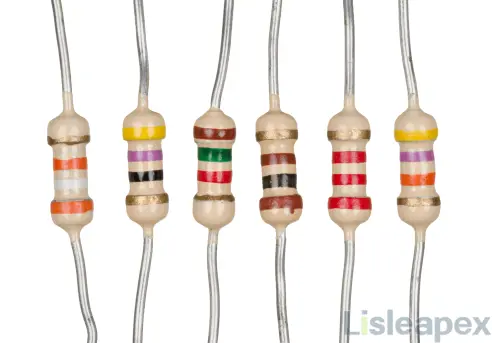
Film resistors are a specific type of resistor characterized by a thin film of resistive material deposited onto an insulating substrate. This film serves as the resistance element of the resistor. Film resistors offer advantages such as high precision, stability, and reliability. They are commonly used in electronic circuits across a wide range of applications.
There are several types of film resistors, each with unique characteristics and applications:
Carbon Film Resistors:
These resistors consist of a ceramic carrier coated with a thin film of carbon. The carbon film provides resistance to the flow of electric current. Carbon film resistors are known for their affordability and are commonly used in consumer electronics.
Metal Film Resistors:
Metal film resistors utilize a thin film of metal alloy, typically nickel-chromium or tantalum nitride, as the resistive material. This type of resistor offers higher precision, stability, and temperature coefficient compared to carbon film resistors. Metal film resistors are often used in precision electronic circuits where accuracy is crucial.
Metal Oxide Film Resistors:
Metal oxide film resistors employ a thin film of metal oxide, such as tin oxide, as the resistive material. Antimony oxide may also be added to enhance resistance properties. These resistors exhibit excellent high-temperature stability and are commonly used in high-power applications.
Thick Film Resistors:
Thick film resistors are manufactured by depositing a thick layer of resistive paste onto a substrate, typically ceramic. This paste contains a mixture of resistive materials, binders, and solvents. Thick film resistors offer higher power handling capabilities compared to thin film resistors and are often used in power electronics.
Thin Film Resistors:
Thin film resistors are fabricated by depositing a thin layer of resistive material onto a substrate using techniques such as sputtering or vapor deposition. This results in precise and stable resistance values with low temperature coefficients. Thin film resistors are commonly used in precision electronic applications where high accuracy is required.
Overall, film resistors play a vital role in electronic circuit design, offering a wide range of options to meet various performance requirements.
What is Carbon Film Resistor
A carbon film resistor is a type of fixed value resistor characterized by a ceramic carrier enveloped in a thin layer of pure carbon film. This film serves as the resistive material, impeding the flow of electric current within a circuit. Manufactured through a process involving the deposition of carbon onto a magnetic rod or ceramic tube, the resistor's resistance can be tailored to specific values by adjusting the thickness of the carbon film. Notch grooving is employed for this purpose.
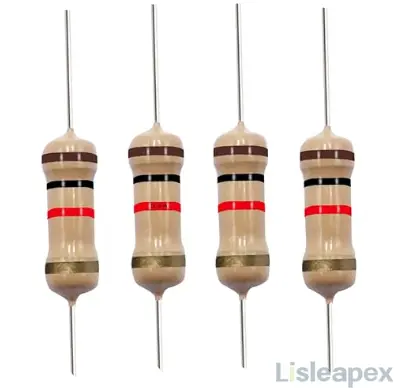
Epoxy is applied to the surface to enhance sealing. Carbon film resistors typically exhibit resistance values ranging from 1Ω to 10MΩ, with rated powers varying between 0.125W to 1W. Precision ranges commonly include ± 10%, ± 5%, and ± 2%. These resistors find application in various electronic devices, such as mobile phone chargers and computer power supplies, owing to their affordability and reliability.
What is Metal Film Resistor
A metal film resistor, also known as a metal oxide resistor, is a high-precision electronic component comprised of a thin metal oxide film enveloping an insulating ceramic rod. In contrast to carbon film resistors, metal oxide film resistors utilize tin oxide as the primary material, often augmented with antimony oxide to enhance resistance properties. These resistors are engineered to withstand elevated temperatures due to the insulating nature of the ceramic rod while effectively impeding the flow of electric current through the metal oxide layer.
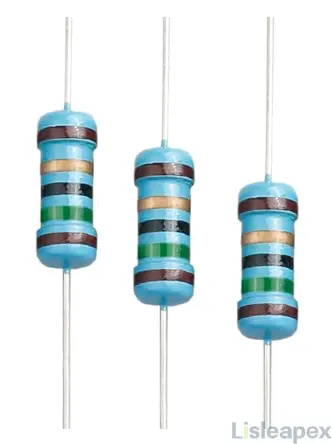
The resistance of metal oxide film resistors is influenced by factors such as the composition of antimony, the thickness of the metal oxide film, and the width of the helical metal oxide film cut. Generally, a greater concentration of antimony corresponds to increased resistance. Moreover, the width of the helical metal oxide film cut and the thickness of the metal oxide are inversely proportional to resistance, further contributing to resistance modulation.
In the manufacturing process, metal film resistors are produced by depositing a metal film onto a ceramic pipe frame through methods like vacuum evaporation or infiltration. The film adheres to the surface of the ceramic, and precise resistance values are achieved through cutting processes. Metal film resistors boast attributes such as high accuracy, compact size, excellent stability, and reliability. They are commonly employed in wireless electronic devices and are favored for their military-grade precision characteristics.
Metal film resistors exhibit superior stability, accuracy, and reliability compared to carbon film resistors. While their appearance may resemble carbon film resistors, their performance characteristics far surpass them, making metal film resistors an integral component in various electronic applications requiring precise resistance values and dependable performance.
Carbon Film vs Metal Film Resistors: Construction
Construction of Carbon Film Resistor
Carbon film resistors are constructed using a solid, cylindrical resistive element with wire leads and metal caps on both ends. The resistive element consists of a mixture of clay-based ceramic and graphite or carbon powder. The carbon powder facilitates the flow of electricity through the resistor. During the manufacturing process, the ceramic substrate is heated in a hydrocarbon gas like methane.
At temperatures around 1000°C, the gas undergoes cracking reactions, causing pure graphite's crystalline carbon to adhere to the ceramic. A protective plastic covering is then applied to shield the resistive material from external heat. Copper is applied to form wire leads at both ends of the resistive element.
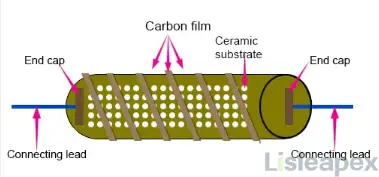
Carbon Film Resistors Construction
Construction of Metal Film Resistor
Metal film resistors are manufactured using a specialized aging process for the deposited metal at low temperatures over an extended duration. Nickel chromium (NiCr) is commonly used as the resistance material, although other materials such as tantalum nitride, gold with platinum, and tin with antimony may be utilized in different applications.
The stability and resistance of the resistor depend largely on the thickness of the metal film. A greater thickness results in lower resistance values and enhanced stability at both ends of the film. Connection leads are used to attach a metal cover during the final assembly. Desired resistance values are achieved by cutting a spiral-shaped slot in the thin metal film.
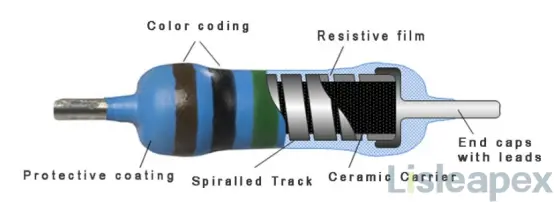
metal film resistors construction
In summary, carbon film resistors utilize a mixture of ceramic and carbon powder, with a protective plastic covering and copper wire leads. On the other hand, metal film resistors employ aged metal deposited on a substrate, with stability and resistance determined by the thickness of the metal film, and a metal cover attached using connection leads.
Carbon Film vs Metal Film Resistors: Voltage and Temperature Coefficient
Voltage and Temperature Coefficients
Metal oxide film resistors exhibit stronger voltage and temperature coefficients compared to carbon film resistors. The voltage coefficient refers to the change in resistance relative to the change in voltage applied to the resistor. Metal oxide film resistors can operate within a wider range of resistances and can withstand higher temperatures than carbon film resistors. They also feature a low noise design, minimizing current-induced noise.
Temperature Coefficient of Resistance (TCR)
Both metal oxide film resistors and carbon film resistors experience changes in resistance with variations in temperature. This phenomenon is quantified by the Temperature Coefficient of Resistance (TCR), expressed in parts per million per degree Centigrade (ppm/°C) or Kelvin (ppm/K). Metal film resistors typically have a TCR between ±20 and ±200 ppm/K, while carbon film resistors exhibit a wider range between -200 to -1000 ppm/K. The lower TCR of metal film resistors renders them more stable and reliable under extreme temperature conditions, making them suitable for applications such as radios, intercoms, and radars.
Voltage Coefficient of Resistance (VCR)
The Voltage Coefficient of Resistance (VCR) measures the change in resistance per applied volt and is expressed in parts per million per volt (ppm/V). Metal film resistors typically have a VCR of just under 1 ppm/V, while carbon film resistors have a VCR of around -10 ppm/V. This means that metal film resistors are less susceptible to changes in resistance induced by applied voltage, making them more suitable for high-voltage applications where stability is crucial.
In summary, metal film resistors outperform carbon film resistors in terms of voltage and temperature coefficients, exhibiting greater stability and reliability under varying voltage and temperature conditions. Additionally, their low noise design makes them ideal for applications requiring minimal current-induced noise.
Carbon Film vs Metal Film Resistors: Application
Applications of Carbon Film Resistors:
- RADARs: Carbon film resistors are used in RADAR systems for various purposes including signal processing, filtering, and amplification circuits.
- X-Rays: In X-ray equipment, carbon film resistors are employed in control circuits, voltage dividers, and other electronic components requiring stable and reliable resistance values.
- Power Supplies: Carbon film resistors find applications in power supply circuits for voltage regulation, current limiting, and voltage division.
- Lasers: Carbon film resistors are utilized in laser systems for controlling laser diode currents, modulation, and feedback circuits.
Applications of Metal Film Resistors:
- High-frequency applications: Metal film resistors are preferred in high-frequency circuits such as RF amplifiers, oscillators, and mixers due to their low noise properties and high frequency response.
- Active filters: Metal film resistors are commonly used in active filter circuits where precise resistance values and low noise characteristics are essential for signal processing and frequency filtering.
- Bridge circuits: Metal film resistors are employed in bridge circuits for applications such as strain gauge measurements, sensor interfacing, and precision instrumentation where accuracy, stability, and low temperature coefficients are critical.
In summary, carbon film resistors find applications in RADARs, X-rays, power supplies, and lasers, where stability and reliability are important. On the other hand, metal film resistors are utilized in high-frequency applications, active filters, and bridge circuits where tight tolerance, low temperature coefficient, and low noise properties are essential for optimal circuit performance.
Carbon Film vs Metal Film Resistors: Similarities and Differences
When comparing carbon film resistors to metal oxide film resistors, several key differences emerge. Metal oxide film resistors excel in various aspects, including voltage and temperature coefficients, noise design, tolerance, and size. Their superior properties make them preferable for applications requiring high performance and reliability. However, carbon film resistors have their own set of advantages and applications. Let's delve into the specifics and then summarize their similarities and differences.
Carbon Film Resistor vs. Metal Oxide Film Resistor:
Carbon film resistors offer moderate performance and are commonly used in various electronic circuits. However, metal oxide film resistors surpass them in several aspects:
- Voltage and Temperature Coefficients: Metal oxide film resistors exhibit stronger voltage and temperature coefficients, ensuring stable performance over a wider range of operating conditions.
- Noise Design: Metal oxide film resistors have a low noise design, minimizing current-induced noise and ensuring cleaner signal transmission.
- Tolerance: Metal oxide film resistors provide tighter tolerance levels, offering more precise resistance values compared to carbon film resistors.
- Size: Metal oxide film resistors are smaller in size, making them more space-efficient and suitable for compact electronic designs.
Similarities and Differences:
|
Aspect |
Carbon Film Resistor |
Metal Oxide Film Resistor |
|
Non-Conducting Material |
Ceramic |
Ceramic |
|
Size |
Small |
Small |
|
Resistance Control |
Film Thickness |
Film Thickness |
|
Temperature Coefficient |
Negative |
Small Positive |
|
Resistance Accuracy |
Moderate |
High |
|
Resistor Color |
Yellow/Pink |
Blue |
|
Protective Paint |
Black |
Bright White |
In summary, while both carbon film and metal oxide film resistors share similarities such as their small size and ceramic construction, they differ significantly in temperature coefficient, resistance accuracy, color, and protective paint. Metal oxide film resistors outperform carbon film resistors in terms of precision, stability, and noise properties, making them preferable for demanding applications requiring high performance and reliability.
Advantages and Disadvantages of Carbon Film and Metal Film Resistors
Advantages of Carbon Film Resistors:
- Generates less noise than carbon composition resistors: Carbon film resistors exhibit lower noise levels compared to carbon composition resistors, making them suitable for applications requiring minimal signal interference.
- Low tolerance: Carbon film resistors offer low tolerance levels, providing consistent and predictable resistance values in electronic circuits.
- Low cost: Carbon film resistors are cost-effective solutions for various electronic applications, offering good performance at a reasonable price point.
- Wide operating range: Carbon film resistors can operate over a wide range of temperatures and voltages, making them versatile for use in diverse environments and applications.
- High temperature and voltage tolerance: They can withstand temperatures up to 350 degrees Celsius and voltages up to 15kV, making them suitable for high-temperature and high-voltage applications.
Disadvantages of Carbon Film Resistors:
High negative temperature coefficient: Carbon film resistors exhibit a high negative temperature coefficient, leading to a decrease in resistance with increasing temperature. This can affect the stability and accuracy of circuits operating in varying temperature conditions.
Advantages of Metal Film Resistors:
- Low cost: Metal film resistors offer cost-effective solutions for various electronic applications, providing reliable performance at an affordable price.
- Generates less noise than carbon composition resistors: Similar to carbon film resistors, metal film resistors produce low levels of noise, ensuring clean signal transmission in electronic circuits.
- Wide operating range: Metal film resistors can operate over a wide range of temperatures and voltages, making them versatile for use in diverse environments and applications.
- Long-term stability: Metal film resistors exhibit excellent long-term stability, maintaining consistent resistance values over extended periods of use.
- Low tolerance: Metal film resistors offer low tolerance levels, providing precise and consistent resistance values in electronic circuits.
- Low-temperature coefficient of resistance: Metal film resistors have a low temperature coefficient of resistance, meaning their resistance values do not change significantly with temperature variations, ensuring stable performance in varying environmental conditions.
- Very small in size: Metal film resistors are compact and lightweight, making them ideal for space-constrained electronic designs where size is a critical factor.
How to Choose between Carbon Film vs Metal Film Resistors
Selecting between carbon film and metal film resistors hinges on your particular circuit requirements. Carbon film resistors offer cost-effectiveness, wide operating ranges, and robust tolerance to high temperatures and voltages, making them suitable for budget-conscious projects with demanding environmental conditions.
Conversely, metal film resistors provide superior long-term stability, precision, low noise characteristics, and compact size, making them ideal for applications prioritizing accuracy, reliability, and space efficiency. Assess your budget constraints, performance criteria, and environmental factors to determine the most suitable resistor type for your specific application.
Here are several dimensions to consider when choosing between carbon film and metal film resistors:
Cost: Evaluate the budget constraints of your project as carbon film resistors are generally more cost-effective compared to metal film resistors.
Precision and Stability: Determine the required level of precision and long-term stability for your application, as metal film resistors typically offer higher accuracy and stability compared to carbon film resistors.
Noise Performance: Consider the sensitivity of your circuit to noise interference, as metal film resistors generally produce lower levels of noise compared to carbon film resistors.
Temperature Coefficient: Assess the temperature variations your circuit will encounter, as metal film resistors typically have lower temperature coefficients compared to carbon film resistors, ensuring stable performance across varying temperatures.
Size and Space Constraints: Take into account the physical size limitations of your circuit board or enclosure, as metal film resistors are typically smaller and more compact compared to carbon film resistors.
Operating Environment: Evaluate the environmental conditions your circuit will be exposed to, including temperature extremes and voltage fluctuations, as this can impact the suitability of each resistor type.
Main Manufacturer
- Vishay Intertechnology
- YAGEO Corporation
- Panasonic Corporation
- KOA Speer Electronics
- TE Connectivity
- Bourns, Inc.
- Ohmite Manufacturing Company
- Riedon Inc.
- TT Electronics plc
- Susumu Co., Ltd.
Conclusion
In conclusion, the choice between carbon film and metal film resistors depends on specific circuit requirements, performance criteria, and environmental factors. Carbon film resistors offer cost-effectiveness and robustness in high-temperature and high-voltage applications, making them suitable for budget-conscious projects with demanding operational conditions.
On the other hand, metal film resistors provide superior precision, stability, and noise performance, ideal for applications prioritizing accuracy, reliability, and space efficiency. By carefully assessing these factors, engineers and designers can make informed decisions to ensure optimal resistor selection for their electronic designs.
FAQ
-
Can both types of resistors handle high power?
Both carbon film and metal film resistors are available in various power ratings, ranging from 0.125 watts to several watts. However, metal film resistors are often preferred for high-power applications due to their better thermal stability and higher power ratings compared to carbon film resistors.
-
Which resistor is more resistant to environmental factors?
Metal film resistors typically exhibit better resistance to environmental factors such as moisture, humidity, and temperature variations compared to carbon film resistors. This makes them more suitable for use in harsh operating conditions or applications where reliability is crucial.
-
Which resistor type is more cost-effective?
Carbon film resistors are generally more cost-effective compared to metal film resistors. They are commonly used in consumer electronics and applications where high precision is not required but cost efficiency is essential.
-
Which resistor is more suitable for precision applications?
Metal film resistors are more suitable for precision applications requiring high accuracy and stability, such as in instrumentation and communication systems. Their tighter tolerance and lower temperature coefficients make them ideal for circuits where precise resistance values are critical.
Stay updated with Lisleapex by signing up for the newsletter


 Congratulations On Your Successful Submission
Congratulations On Your Successful Submission
 Submission Failure
Submission Failure